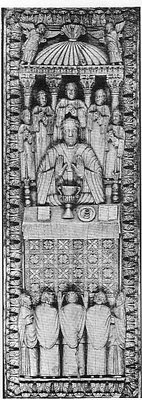I checked out a copy of Kenneth Clark's
Civilization from the library (that's a story for another time) and in it I found this picture of a carved ivory book from from the 10th century. The subject is clearly the mass being celebrated. Yet it looks very much as if the priest is facing the people rather than
ad orientem. Was this sometimes done pre-Trent, or are we essentially seeing a God's-eye-view of the mass in this picture?



4 comments:
"Ad orientem" means "facing the East" not "facing away from the people." In a number of Roman churches -- St. John Lateran, St. Peter's and St. Mary Major, among others -- to turn "ad orientem" means precisely to face over the altar towards the nave and congregation (who may however, have stood at the sides, rather than directly in front of the altar). Some churches built in the Rhineland in the 9th & 10th centuries were also built in this way. So before drawing any conclusions about "10th Century Liturgical Abuse" one would have to attempt to establish both the provenance of the object and the nature of the intended depiction. It could be (especially given the canopy over the altar) a representation of a Mass in one of the Roman churches (given the small-sized figures in the lower part of the depiction I rather doubt that it is intended as a "God's-eye-view of the Mass").
For more on this subject, see Uew Michael Lang's recent book *Turning Towards the Lord: Orientation in Liturgical Prayer* (Ignatius Press, 2004; ISBN: 0-89870-986-5) or *The Christian Altar* by Cyril Pocknee (1962) or "Eis anatolas blepsate: Orientation as a Liturgical Principle" by M. J. Moreton, in *Studia Patristica, Volume XVIII in Three Parts* ed. Elizabeth A. Livingstone (Oxford and New York, 1982: Pergamon Press), pp. 575-590.
Thanks, William. I'll have to take a look for those books some time.
Just to be clear, the '10th Century Liturgical Abuse' title was intended to be rather tongue in cheek.
Though it's interesting that while the posture was universally one of facing east while celebrating the mass, the layout of the churches varied such that this sometimes meant facing the people, and other times meant facing the apse.
On a semi-related topic, do you know of a good book on the liturgy as celebrated in the early and high middle ages? I gather Trent did not represent a radical departure from what came before, but I've always been curious how the Tridentine liturgy differed from what came before it.
A happy, blessed Father's Day to you, Darwin!!
Eamon Duffy, in The Stripping of the Altars, gives a very thorough examination of pre-Reformation religious practice in England. I recall a reference to priests complaining that parishioners would crowd too close to the (side) altar (there wouldn't have been a rood screen between the priest and people), to the point of jostling the priests' elbows. A little surprising, but I suppose you could end up with a situation like in the carving, with the people surrounding the altar.
Or maybe the carving just shows the choir in an odd place. Or maybe it's like one of those medieval maps with the world in four quarters, the Ocean River around them, and Jerusalem in the middle; it's not that that's what the monks thought was accurate topography, but what they thought was accurate spiritual topography.
Post a Comment